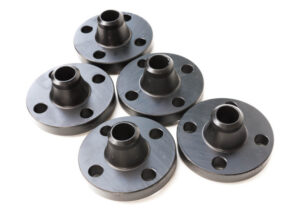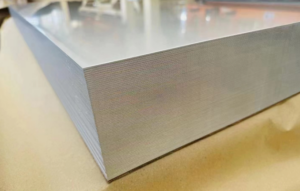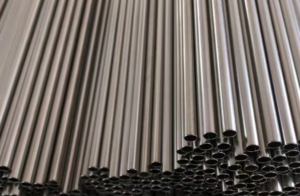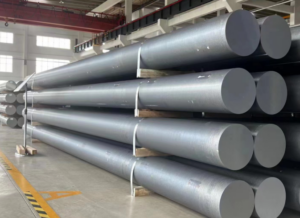Hastelloy C-22
Hastelloy C-22 is a versatile nickel-chromium-molybdenum-tungsten alloy that offers superior overall corrosion resistance compared to other existing nickel-chromium-molybdenum alloys, including Hastelloy C276, C4 alloys, and alloy 625.
Applicable Standards for Hastelloy C-22
| Product Form | Standard | Description |
|---|---|---|
| Rod, Bar, and Wire | ASTM B574 | This standard specifies the requirements for rod, bar, and wire of Hastelloy C-22, including chemical composition, mechanical properties, and other necessary details. |
| Plate, Sheet, and Strip | ASTM B575 | This standard covers the requirements for plate, sheet, and strip of Hastelloy C-22, detailing specifications like thickness, mechanical properties, and chemical composition. |
| Seamless Pipe and Tube | ASTM B622 | ASTM B622 standard specifies the requirements for seamless pipe and tube made of Hastelloy C-22, including dimensions, mechanical properties, and chemical composition. |
| Welded Tube | ASTM B626 | This standard is specific to welded tubes made from Hastelloy C-22, outlining the necessary specifications such as weld integrity, dimensions, and material properties. |
| Fittings | ASTM B366 | ASTM B366 covers the specifications for wrought factory-made wrought nickel and nickel alloy fittings, including Hastelloy C-22. It specifies dimensions, tolerances, and material properties. |
| Forgings | ASTM B564 | This standard includes the specifications for nickel alloy forgings, applicable to Hastelloy C-22, detailing the mechanical properties, allowable stress, and other essential attributes. |
Content

Applications of Hastelloy C-22
Hastelloy C-22 is renowned for its exceptional resistance to a wide range of harsh chemical environments, including strong oxidizers like ferric and cupric chlorides, chlorine, hot contaminated solutions (organic and inorganic), formic and acetic acids, acetic anhydride, and seawater and brine solutions. It also offers excellent resistance to pitting, crevice corrosion, and stress-corrosion cracking. Here are some applications that leverage these unique properties of Hastelloy C-22:
Chemical Processing Industry: Hastelloy C-22 is extensively used in reactors, heat exchangers, columns, and piping in the chemical processing industry, especially where acids and highly corrosive chemicals are processed.
Pharmaceutical Industry: Due to its excellent resistance to a variety of aggressive media, C-22 is used in pharmaceutical reactors and equipment where product purity is essential, and the equipment must withstand corrosive agents.
Pollution Control: In scrubbers and ducting systems designed for controlling industrial emissions, Hastelloy C-22 is chosen for its resistance to the wide range of chemicals found in industrial effluents and its ability to withstand high temperatures.
Pulp and Paper Industry: Hastelloy C-22 is used in bleaching plants, digesters, and other areas where the equipment is exposed to highly corrosive substances used in the paper whitening and pulping processes.
Waste Treatment: The alloy is used in waste treatment facilities, especially where industrial waste is chemically aggressive or contains acidic byproducts that can cause corrosion.
Geothermal Wells: Hastelloy C-22 is used in applications within geothermal wells where there are high levels of hydrogen sulfide, carbon dioxide, and chlorides, all of which are highly corrosive.
Flue Gas Desulfurization Systems: The alloy’s resistance to sulfur compounds and chloride ions makes it suitable for flue gas desulfurization systems, which are essential for reducing sulfur dioxide emissions from power plants.
Marine Engineering: Its excellent resistance to seawater and brine solutions makes Hastelloy C-22 a suitable choice for marine hardware, and in seawater heat exchangers.
Food Processing Equipment: Hastelloy C-22 is used in food processing environments where cleanliness and non-contamination are essential, and the equipment may be exposed to various acidic foods and cleaning chemicals.
The unique combination of high nickel, chromium, molybdenum, and tungsten content contributes to Hastelloy C-22’s outstanding resistance to a broad spectrum of corrosive environments, distinguishing it from other materials in demanding applications.
Chemical composition of Hastelloy C-22(%)
| Element | Percentage (%) |
|---|---|
| Nickel (Ni) | 56.0 min |
| Chromium (Cr) | 20.0 – 22.5 |
| Molybdenum (Mo) | 12.5 – 14.5 |
| Tungsten (W) | 2.5 – 3.5 |
| Iron (Fe) | 2.0 – 6.0 |
| Cobalt (Co) | Max 2.5 |
| Carbon (C) | Max 0.010 |
| Silicon (Si) | Max 0.08 |
| Manganese (Mn) | Max 0.50 |
| Vanadium (V) | Max 0.35 |
| Phosphorus (P) | Max 0.02 |
| Sulfur (S) | Max 0.02 |
Physical properties of Hastelloy C-22
| Physical Property | Value | Unit |
|---|---|---|
| Density | 8.69 | g/cm³ |
| Melting Point | 1399 – 1446 | °C |
| Specific Heat Capacity | 427 | J/kg·K |
| Thermal Conductivity | 10.2 | W/m·K |
| Coefficient of Expansion | 12.4 (at 20-100°C) / 13.7 (at 20-600°C) | µm/m·K |
| Electrical Resistivity | 1.3 | µΩ·m |
| Modulus of Elasticity (Tension) | 206 | GPa |
Mechanical properties of Hastelloy C-22
| Mechanical Property | Value (Typical for Room Temperature) | Unit |
|---|---|---|
| Tensile Strength | 690 – 790 | MPa |
| Yield Strength (0.2% Offset) | 310 – 450 | MPa |
| Elongation | 45 – 60 | % |
| Hardness | 89 – 100 | Rockwell B |
| Reduction of Area | 50 – 60 | % |
FAQs about Hastelloy C-22
The hardness of Hastelloy C-22, a nickel-chromium-molybdenum alloy known for its exceptional corrosion resistance, is typically measured using the Rockwell B scale. The typical hardness value for Hastelloy C-22 falls within the range of 89 to 100 on the Rockwell B scale. This scale is commonly used for materials that are softer than those measured on the Rockwell C scale, which is used for harder materials.
In the context of metals, the Rockwell hardness test measures the depth of penetration of an indenter under a large load compared to the penetration made by a preload. The Rockwell B hardness of 89 to 100 indicates a moderate level of hardness, which means that while Hastelloy C-22 is not as hard as some high-carbon steels or hard metal alloys, it still provides a good resistance to wear and deformation under moderate loads.
The specific hardness level of Hastelloy C-22 contributes to its suitability for various industrial applications where it must withstand mechanical stress and wear while offering outstanding corrosion resistance. However, it’s important to note that the hardness is just one of many properties that make Hastelloy C-22 a preferred material in challenging environments, including chemical processing, pollution control, and marine engineering.
The density of Hastelloy C-22, a nickel-chromium-molybdenum alloy, is approximately 8.69 grams per cubic centimeter (g/cm³). This value is an important physical characteristic, as it provides insight into the alloy’s mass per unit volume and plays a critical role in various applications and engineering calculations.
In practical terms, the density of Hastelloy C-22 is higher than that of many common metals and alloys, reflecting its substantial nickel content. Nickel itself has a density of around 8.9 g/cm³, contributing to the overall density of Hastelloy C-22. The high density is indicative of the compact atomic structure of the alloy, which is also related to its high strength and corrosion resistance properties.
Understanding the density of Hastelloy C-22 is crucial for designing and engineering components, especially in fields where material weight and strength are critical factors, such as aerospace, marine, chemical processing, and construction. It helps in estimating the weight of a Hastelloy C-22 component based on its volume, which is essential for structural design, transportation, and installation processes.
Hastelloy C-22 and Hastelloy C-276 are both nickel-chromium-molybdenum alloys, but they have distinct compositions that confer different properties and make them suitable for different applications. Here’s a comparison of the two:
Chemical Composition:
- Hastelloy C-22: It typically contains 22% chromium, 13% molybdenum, and 3% tungsten, with the balance being nickel. It’s designed to offer enhanced resistance to pitting, crevice corrosion, and stress-corrosion cracking.
- Hastelloy C-276: This alloy contains a bit less chromium at 16%, more molybdenum at 16%, and no tungsten. It’s known for its durable resistance to oxidizing and reducing environments.
Corrosion Resistance:
- Hastelloy C-22: Due to its higher chromium, molybdenum, and tungsten content, C-22 offers superior resistance to both oxidizing and reducing media, including chlorides. It performs better in environments where pitting and crevice corrosion are concerns.
- Hastelloy C-276: While C-276 is extremely resistant to corrosion in a wide range of chemical environments, including strong oxidizers like ferric and cupric chlorides, it may not perform as well as C-22 in environments with high risks of pitting and crevice corrosion.
Applications:
- Hastelloy C-22: Often chosen for its enhanced corrosion resistance in environments where conditions exceed the capabilities of C-276, particularly in the presence of mixed acids and aggressive media.
- Hastelloy C-276: Used in a variety of harsh environments, particularly those featuring strong acids. Though not as resistant to pitting and crevice corrosion as C-22, it is still a popular choice for chemical processing, pollution control, and waste treatment.
Mechanical Properties: While both alloys have excellent mechanical properties at both high and low temperatures, the slight differences in their chemical compositions could lead to variations in strength, ductility, and thermal stability.
In summary, while both Hastelloy C-22 and C-276 offer outstanding corrosion resistance, the choice between them typically depends on the specific environmental conditions and the type of corrosion that is most concerning for the application. C-22 is generally preferred when the strongest resistance to pitting, crevice corrosion, and stress-corrosion cracking is required.






